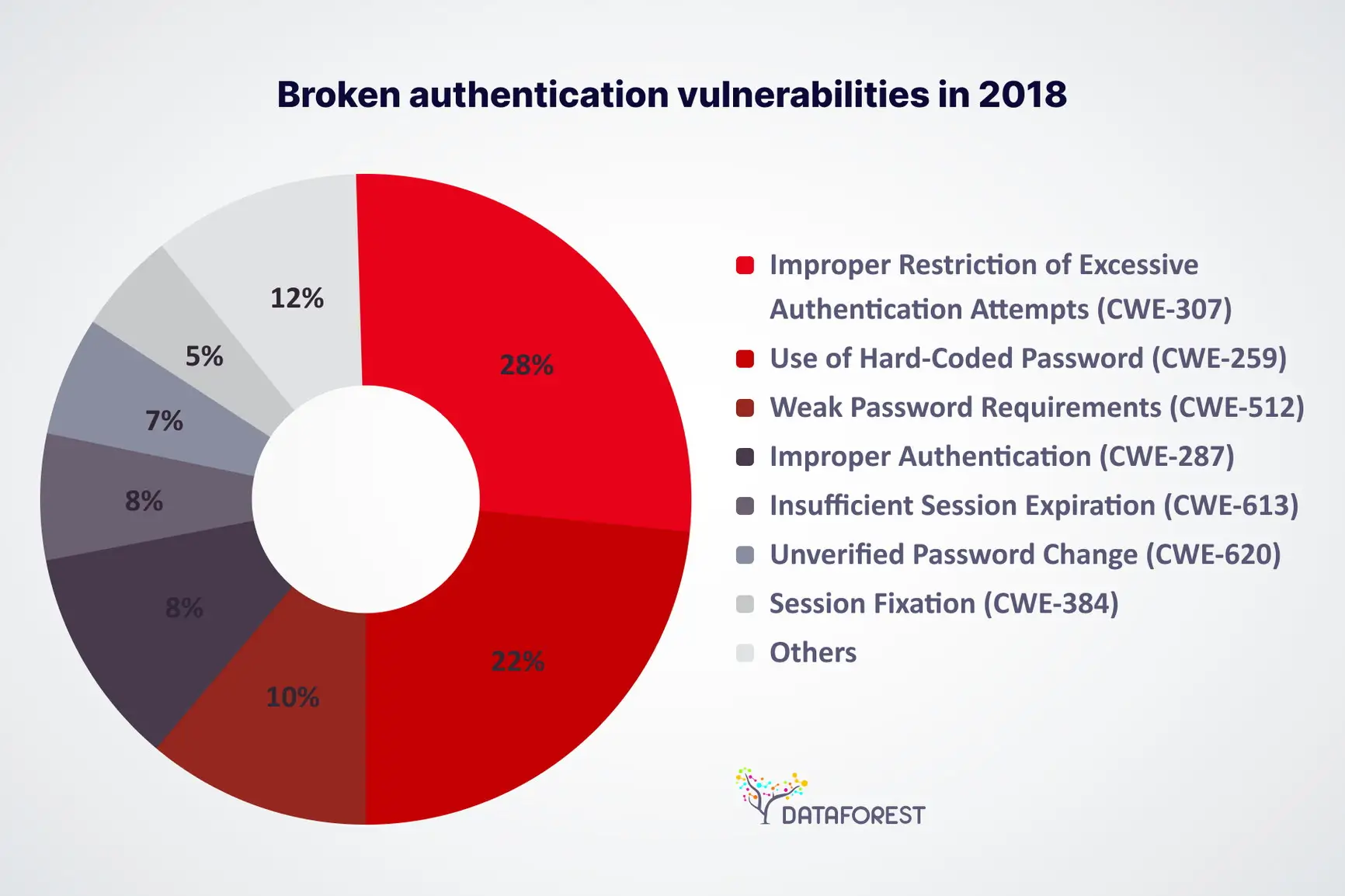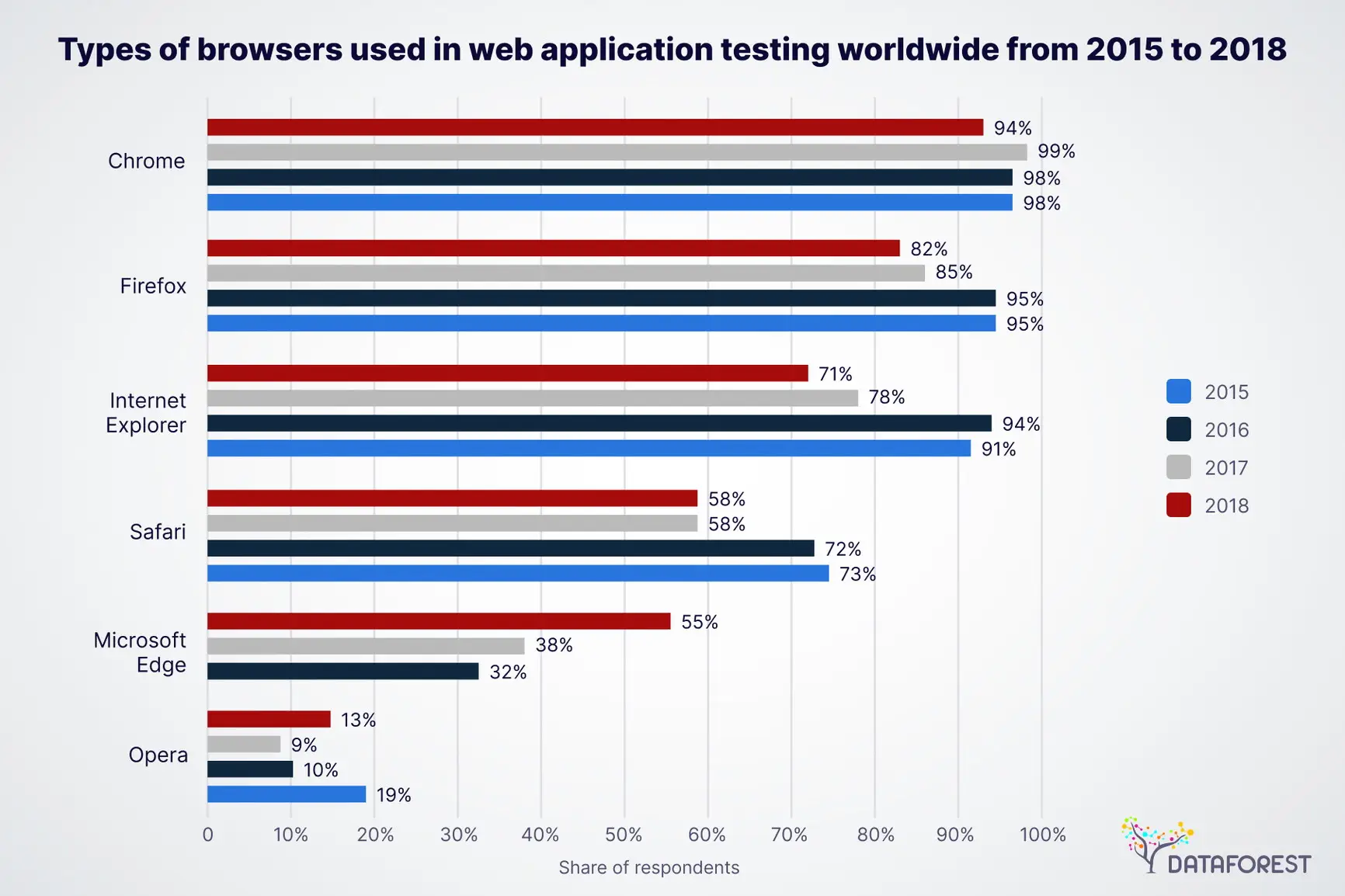Enterprise web app testing and validation can be compared to a skilled surgeon meticulously examining and diagnosing a patient, delicately probing and scrutinizing every aspect of the web application's functionality, performance, security, and usability to ensure its health, stability, and optimal performance in the complex ecosystem of the enterprise.
Enterprise Web App Testing and Validation Is a Roadmap
The introduction to enterprise web app testing and validation is like a roadmap that guides through the process of thoroughly examining and verifying the functionality, security, and performance of a web application designed for enterprise use. Conducting comprehensive agile testing identifies and addresses any issues or defects before deploying the application into the enterprise environment. Book a call, get advice from DATAFOREST, and move in the right direction.
Assessing web app testing to industry standards
Enterprise web app testing and validation means assessing the app's performance, usability, and adherence to industry standards and identifying and fixing any defects or vulnerabilities. The goal is to deliver a high-quality, reliable web application that meets the needs of the enterprise environment.
Meeting the specific needs of web app testing
Enterprise web app testing and validation are crucial for businesses as they guarantee that the web application functions correctly, meeting the specific needs of the company and its end users. Businesses identify and rectify any issues before the app is deployed, reducing the risk of costly errors or security breaches. It helps to deliver a reliable web application that enhances productivity, user satisfaction and maintains a competitive edge.
Enterprise Web App Testing Techniques
The techniques for testing enterprise web apps are needed to warrant functionality, performance, and security to meet the business's and its users' needs and expectations. Employing these procedures resolves any vulnerabilities, reducing the risk of downtime. Ultimately, testing techniques aid businesses in bringing high-quality web apps that increase yield. Interested in the update? Book a call and we'll tell you what's what.
Common web app testing cases studies
- Functional Testing verifies that the web application's features and functions work as intended.
- Performance Testing assesses the web application's responsiveness, scalability, and resource usage under various load conditions.
- Application security testing is crucial to identify vulnerabilities and weaknesses in the web app's design and implementation.
- Usability testing evaluates the user-friendliness and intuitiveness of the web application's interface.
- Compatibility testing ensures the web app works correctly across browsers, operating systems, and devices.
- Regression testing is performed to change or update the web app, not to introduce new defects or negatively impact existing functionality.
- Load testing involves testing the web app's performance and stability under high load.
- Accessibility testing checks if the web app is accessible to users with disabilities.
Ensuring test coverage for an enterprise web app testing
- Start with a deep understanding of the requirements and specifications of web app testing. It identifies the key features, functionalities, and use cases that must be tested.
- Develop a test plan that outlines the web app testing objectives, test scenarios, and test cases to be executed.
- Prioritize test cases based on their criticality and impact on the application.
- Perform functional web app testing to ensure that all features, functions, and user interactions are tested comprehensively.
- Test edge cases, unusual inputs, and extreme scenarios that typical web app testing cases may not cover.
- Include negative test scenarios to validate how the web app testing handles invalid inputs, error conditions, and exception cases.
- Conduct compatibility web app testing across different browsers, operating systems, and devices to ensure the web app functions correctly in various environments.
- Perform web app testing to assess the web app's response times, throughput, and scalability under different load conditions.
- Include security web app testing to identify and address potential vulnerabilities, such as penetration testing and code review.
- Evaluate the user-friendliness and ease of use of the web app testing through usability checking.

Software tools to execute web app testing automatically
Automated testing for enterprise web apps offers efficiency by saving time and effort compared to manual testing. Automated web testing also qualifies faster feedback on the application's quality, enabling quicker identification and resolution of issues. Additionally, it facilitates the testing of complex scenarios and multiple configurations by running tests on different browsers, platforms, and devices simultaneously.
Automated testing for enterprise web apps uses the following steps:
- Choose a suitable automation testing framework or tool that aligns with the requirements and technologies used in web app development. Popular frameworks include Selenium, Cypress, and Puppeteer.
- Create automated test scripts using the chosen framework. They simulate user interactions, perform validations, and check the expected behavior of the web app. Test scripts can be written in programming languages like Java, Python, or JavaScript.
- Run the automated test scripts against the web app to execute the defined test cases. The automation tool interacts with the application's user interface, performs actions, and verifies the expected outcomes.
- Analyze the test results generated by the automation tool. Identify any failures, errors, or discrepancies between expected and actual outcomes. Detailed logs and reports succor in troubleshooting and debugging issues.
- As the web app evolves and changes, update the automated test scripts to accommodate new features or modifications. Regular maintenance confirms the continued effectiveness of the automated tests.

Simultaneous learning in web app testing
Exploratory testing is software testing that emphasizes simultaneous learning, test design, and execution. It presumes dynamically exploring the software, executing test cases on the fly, and actively learning from the testing process to uncover defects, usability issues, and other potential risks. It is beneficial in the following scenarios:
- In the early stages of development testing when the requirements still need to be fully defined or documented.
- When time constraints or limited documentation make formal test cases in advance impractical, exploratory testing shines.
- To evaluate a user experience, web app testers navigate the app, perform user tasks, and assess the overall usability.
- Exploratory testing effectively uncovers defects that may not be easily identified through traditional scripted testing.
- Make alongside automated or manual scripted tests to enhance test coverage that other methods may have missed.
Exploratory testing relies on testers’ skills, experience, and creativity to uncover defects and provide valuable feedback to improve quality assurance.
Enterprise Web Apps Verifying
Validating enterprise web apps is verifying that the web application meets the intended requirements, functions correctly, and performs as expected in the enterprise environment. The goal is to validate that the web app is reliable, secure, and capable of meeting the enterprise's and its users' specific needs and expectations.
Series of steps
- Understand the enterprise's and its users' specific expectations for the web app.
- Develop a comprehensive test plan that outlines the test cases to be executed.
- Execute functional testing, performance testing, security testing, usability testing, and compatibility testing.
- Identify any issues, defects, or vulnerabilities discovered during alpha testing.
- Address the identified issues by working with the development team to fix defects.
- Conduct additional beta testing to verify that the issues have been resolved.
- Once the web app testing meets the defined criteria, provide validation sign-off to indicate the app is ready for deployment in the enterprise environment.
User inputs validation
- Verify that the user fills in mandatory fields before submitting the form during web app testing.
- As part of web app testing, validate that the input data follow the specified format, such as email addresses, phone numbers, dates, or numeric values.
- Check the length of user inputs to ensure they don't exceed the specified limits as part of web app testing.
- During web app testing, validate that the input matches the expected data type, such as numbers, text, or specific formats like URLs or file extensions.
- Implementing web app testing ensures that numeric inputs fall within the acceptable range or the specified minimum and maximum values.
- Implement measures to prevent malicious scripts or code injection by sanitizing user inputs and encoding special characters for web app testing.
- During web app testing, sanitize user inputs to neutralize potentially harmful characters, protecting against SQL injection attacks.
- Implement server-side validation to double-check user inputs and ensure data integrity. It prevents manipulation of client-side validation in web app testing.
Recent changes — no defects
Regression testing verifies that recent changes or updates to an enterprise web app testing have not unintentionally introduced new defects or caused existing functionalities to break. It assumes retesting previously tested features and functionalities to ensure they work as expected after modifications.
Regression testing is important for enterprise web app testing because it checks the stability and reliability of the application throughout its lifecycle. As web apps undergo updates, bug fixes, or enhancements, regression testing is of service to identify any unintended consequences that may have been introduced.
Protection measures
Ensuring the security and performance of an enterprise web app testing involves implementing various measures to protect against potential vulnerabilities and optimize its speed and efficiency.
By addressing security vulnerabilities and optimizing app performance, enterprises protect their web app and provide a seamless and efficient user experience when web app testing is provided.
The Collective Experience for Web App Testing and Validation
Best practices for enterprise web app testing and validation have emerged over time through the lessons learned by software development and testing professionals. These web app testing practices have been refined based on the evolving needs, challenges, and advancements in web app testing development.
Some best web app testing practices
- Develop a well-defined test plan covering all relevant web app testing aspects.
- Use automation tools and web app testing frameworks to automate repetitive and time-consuming cases.
- Manage test data effectively to cover various scenarios and edge cases during web app testing.
- Make integration testing activities into the development process using CI/CT in web app testing practices.
- Implement a robust security testing strategy to protect against potential attacks as a part of web app testing.
- Assess the performance of the web app testing using load, stress, and performance profiling.
- Conduct interface testing to evaluate the user experience and user interface for web app testing.
- Web app testing fosters effective collaboration among the development, testing, and business teams.
- Maintain dedicated test environments that closely resemble the production environment when making web app testing.
- Track relevant test metrics to assess the effectiveness of testing efforts to make web app testing effective.
Ensuring web app testing effective communication
- Before web app testing, set up clear communication channels between developers and testers, such as dedicated communication tools, project data management platforms, or collaborative workspaces.
- Conduct web app testing regular meetings, such as daily stand-ups or sprint planning sessions, to foster direct communication and alignment between developers and testers.
- Provide web app testing developers with comprehensive test plans, cases, and relevant documentation.
- Utilize a shared bug-tracking system or issue management tool where developers and testers log and track defects during web app testing.
- Encourage a culture of open and constructive communication where web app testing developers and testers feel comfortable sharing ideas, concerns, and feedback.
- Include developers in test planning discussions to gain insights, clarify requirements, and identify potential challenges after web app testing.
- Hold regular retrospectives or post-mortem sessions to reflect on the web app testing process, identify communication gaps or bottlenecks, and propose improvements.
In this way, companies facilitate effective communication between developers and testers, improving collaboration and enhancing overall testing process efficiency for web app testing.

Web App Testing and Validation Mitigate Risks
By testing and validating a web app in detail, businesses address potential performance issues, reducing the risk of application failures, security data breaches, or negative user experiences. As a web app testing service provider, DATAFOREST provides a more stable, secure, and reliable web app, leading to increased customer satisfaction, trust, and business success.
Productive trinity
The key takeaway from web app testing and validation is that businesses must verify web application quality, security, and reliability through comprehensive testing processes, a collaboration between developers and testers, and adherence to best practices. Our company has these and other opportunities thanks to experience, so fill out the form if you need web app testing and validation advice.
FAQ
What is enterprise web app testing, and why is it important?
Enterprise web app testing is the validating the functionality, performance, security, and user experience of web-based applications designed for business use, and it is important to ensure a high-quality, secure, and reliable web app that meets business objectives, user needs, and regulatory requirements for web app testing.
What are some common techniques used to test and validate enterprise web apps?
Some common web app testing techniques used to test and validate enterprise web apps include functional, performance, security, usability, and browser compatibility testing across different browsers and devices. In the beginning, you can check the web app testing strategy.
How do you identify the critical features of an enterprise web app for testing purposes?
To identify critical features for testing an enterprise web app, it is important to analyze business requirements, user expectations, and potential risks, prioritizing functionalities core to the app's functionality, security, and user experience before web app testing.
What is the role of test automation in enterprise web app testing, and how does it help?
Test automation in the enterprise web app or web page testing is crucial in improving efficiency and accuracy by automating repetitive and time-consuming test cases, enabling faster execution, enhanced test coverage, and early detection of issues when a company provides web app testing.
How do you ensure the security of an enterprise web app during the testing process?
Ensuring the security of an enterprise web app during the web app testing process is important to conduct comprehensive security testing, including vulnerability assessments, penetration testing, and code reviews, while adhering to secure coding practices by web testers.
What is performance testing, and how is it used in enterprise web app and database testing?
Performance testing is the process of assessing the responsiveness, scalability, and stability of an enterprise web app testing under varying workload conditions, aiming to identify and address performance bottlenecks, ensure optimal user experience, and support the app's ability to handle expected user loads and growth with increased test management for more web app testing results.
How do you test the usability and accessibility of an enterprise web app?
In testing the usability of an enterprise web app, user-centered web app testing approaches are employed, involving real users or testers who simulate user interactions and assess the app's ease of use, intuitive navigation, clarity of content, adherence to accessibility standards, inclusivity for users with disabilities. The same is true if you test a website.
How do you test the compatibility of an enterprise web app across different devices and platforms?
To test the compatibility of an enterprise web app testing across different devices and platforms, a combination of manual browser testing and web app testing automated tools is used to verify that the app functions correctly, displays properly, and provides in the front end a consistent UX across various browsers, operating systems, screen sizes, and resolutions with quality control of different types of websites.
How do you track and report issues discovered during enterprise web app testing, and what testing tools are commonly used for this purpose?
Issues discovered during web app end testing are typically tracked and reported using issue tracking or bug tracking tools, such as Jira, Bugzilla, or Trello, which allow testers to log, assign, track, and prioritize issues, providing a centralized platform for communication, collaboration, and issue resolution among the web app testing team and developers. You also can use different testing types when testing websites and web services.
What is the difference between functional and non-functional testing, and how are they used in enterprise web app testing?
Functional continuous web app testing focuses on verifying that the web app meets its intended functionality and requirements. In contrast, non-functional testing, such as performance, security, and usability web app testing, evaluates aspects beyond functionality to ensure the app's performance, safety, and user experience meet desired standards, which are essential in comprehensive enterprise web app testing.
Is web app testing similar to website testing?
Web app testing typically refers to testing the functionality, performance, security, and other aspects of interactive web applications that involve complex business logic and user interactions for web app testing. Web apps are more dynamic and interactive, often involving user authentication, web app testing processing, and database interactions. On the other hand, website testing generally focuses on website QA testing the content, layout, navigation, and usability of informational or static web pages that primarily provide information from website testers and do not mean complex user interactions or backend processing to web server work. It needs special website testing tools.




.webp)




.webp)















